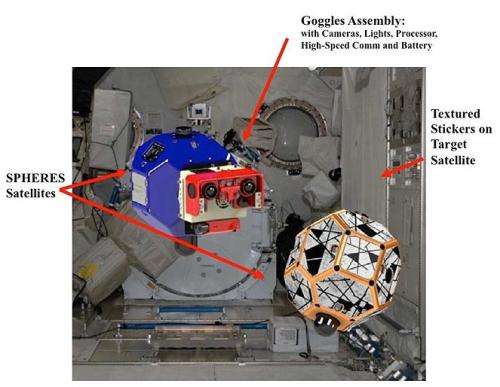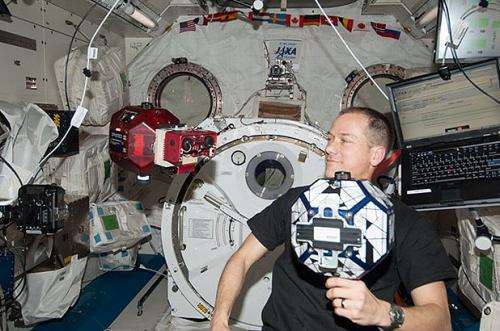The SPHERES have eyes

(Phys.org) —It looks like something out of a sci-fi movie...free-formation-flying robotic spheres hovering around the International Space Station with goggles on. The Visual Estimation and Relative Tracking for Inspection of Generic Objects (VERTIGO) study, a part of the Synchronized Position, Hold, Engage and Reorient Experimental Satellites (SPHERES) investigation explores the use of small satellites equipped to analyze and capture data from specified objects, producing a 3-D model of those objects.
The 1.6 kilogram VERTIGO goggles designed for each SPHERES satellite are similar to a small computer tablet—with 1.2 gigahertz data processor, camera, Wi-Fi device and batteries—allowing the satellite to see what it is navigating around. This technology could result in techniques for space recycling of old aperture satellites or mapping of an asteroid for exploration, among other missions.

In a March 26 interview on NASA Television, Brent Tweddle, a doctoral candidate at the Space Systems Laboratory at the Massachusetts Institute of Technology in Cambridge, Mass., said the goggles allow for each satellite to, "see, perceive and understand its world visually. We use that … to communicate that information to the SPHERES satellites using a package called the VERTIGO goggles. [The goggles] are their own little intelligence block that sticks on the front-end of the SPHERES satellite and allows it to see the rest of the world that it wants to navigate through."
Tweddle talked about a variety of topics related to the SPHERES and VERTIGO during the interview, including the different teams interested in this research. He described how the SHPERES are commanded by algorithms. Tweedle also spoke on the February 2012 test run and future SPHERES tests.
The VERTIGO addition to the SPHERES satellites is part of the Defense Advanced Research Projects Agency-funded International Space Station SPHERES Integrated Research Experiments (InSPIRE) program that leverages the human presence in space for rapid, iterative experimentation and design of space capabilities. It is providing the next generation of scientists and engineers (through the ZERO Robotics Competition) with exposure and experience in carrying out meaningful space experimentation economically and over reasonable time scales.
Provided by NASA





















